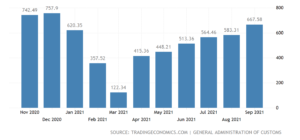Part one of a two-part series.
American businesses have profited from China. They benefit from access to the world’s largest market and they’re able to import goods at a lower price than if they were produced domestically. In 2019, before the pandemic, trade with China totaled $634.8 billion, although imports exceeded exports by 289%.
But is doing business with China worth it?
China may be one of America’s biggest trading partners – but China is costing us trillions of dollars a year. Along with its cheap products, China is the world’s leading exporter of viruses, pollution, deadly synthetic drugs, counterfeit goods and even human organs, harvested from Chinese citizens.
It would be impossible to put a price on the lives lost and human suffering caused by the Chinese Communist Party’s cruelty, negligence, and disregard for anyone who is not a party official. China treats its citizens as an expendable commodity and treats the rest of the world no better.
Consider just a few of the reasons why doing business with China may not be worthwhile.
The COVID-19 pandemic. In spite of stonewalling, denial and blame shifting by the Chinese Communist Party (CCP), it is all but certain that COVID-19 originated with a leak from the Wuhan Institute of Virology.
It’s bad enough that China allowed COVID-19 to be unleashed on the world. The CCP is still denying responsibility, even as the coronavirus has infected more than 237 million people, causing more than 4.8 million deaths. In the United States, 45 million Americans have been infected and close to 728,000 people have died.
And yet China claims that, with a population of 1.4 billion, it has had fewer cases of COVID-19 than Rwanda, which has a population of 13.6 million people. China’s claim of having 96,423 cases and only 4,636 deaths would rank it 112th among the world’s countries for COVID cases.
If that’s true, shouldn’t China be sharing the secrets of its success with the rest of the world, instead of preventing investigators from studying the origin of the disease in China?
And if the numbers are true, China must have developed an amazing vaccine. But it appears that China’s vaccines are only 50% to 79% effective. In contrast, the U.S., thanks to Operation Warp Speed, has developed the two best COVID vaccines in the world. The Pfizer vaccine is 90% effective, while the Moderna vaccine is more than 95% effective!
The economic lockdown at the start of the pandemic resulted in the loss of 22 million jobs. Our economy is still recovering, with supply chains severely disrupted, contributing to rising inflation. The federal government has spent $6 trillion to fight COVID-19, but the ultimate cost, including state and local government costs as well as costs to private businesses and U.S. citizens is more like $16 trillion.
Other viruses. COVID-19 is not the first virus to originate in China and spread throughout the world. Other viruses that originated in China include H2N2 (1957-1958); H3N2 (1968-1969); H56N1, also known as bird flu (1997-2006), and SARS (2009). H1N1, also known as swine flu, may have also originated in China, although the earliest cases were reported in Mexico.
Will China be the source of future viruses? There is already evidence of new strains coming from China.
Environmental damage. As China’s economy has developed, it has become the world’s leading polluter.
Since 2011, China has consumed more coal than the rest of the world combined. And while China is adding more wind, solar and nuclear energy, it is also “leading the world in new coal power plants, building more than three times as much new coal power capacity as all other countries in the world combined in 2020,” according to Time.
China is also, by far, the leading producer of carbon dioxide emissions. China produces more than a quarter of the world’s greenhouse gas emissions.
“The (People’s Republic of China) has been the world’s largest annual emitter of greenhouse gases since 2006, and its emissions are increasing,” according to the U.S. Embassy. “Energy-related emissions of carbon dioxide in the PRC have increased more than 80% between 2005 and 2019, while U.S. energy-related emissions dropped by more than 15% during the same period, according to the International Energy Agency.”
China is home to 22 of the 28 most polluted cities in the world. Since 2000, more than 30 million people in China have died because of illnesses caused by air pollution, according to New Scientist, but China’s pollution also threatens “global health and the world’s economy.”
The opioid crisis. Then there’s fentanyl. As the Brookings Institution reported, “Since 2013, China has been the principal source of the fentanyl flooding the U.S. illicit drug market — or of the precursor agents from which fentanyl is produced, often in Mexico — fueling the deadliest drug epidemic in U.S. history.”
The cost of dealing with the opioid crisis in the U.S. now tops $1 trillion a year. Nearly 70,000 Americans died from an opioid overdose in 2020.
Of course, China is not solely responsible for the crisis, but it is a leading contributor. And chemists working in underground labs in China are designing new, ever-more powerful derivatives. Fentanyl is 100 times more powerful than morphine. Carfentanil, an elephant tranquilizer, is 10,000 times stronger. Derivatives of both have been developed in China and exported to the U.S.

